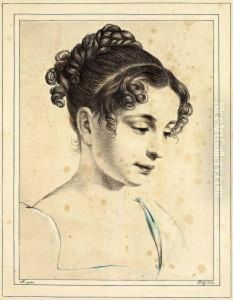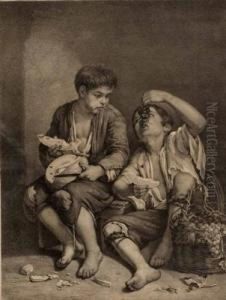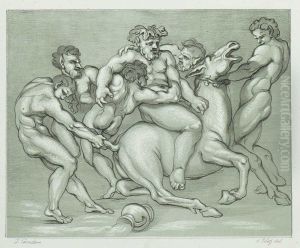Ferdinand I Piloty Paintings
Ferdinand I Piloty was a German lithographer and painter, born on June 12, 1786, in Zweibrücken, Bavaria. He was not widely recognized for major artistic contributions like some of his contemporaries, but he played an important role in the Munich art scene and was a pioneer in the field of lithography in Germany.
Piloty's early life and training are somewhat obscure, but it is known that he started his artistic career as a painter. His interests, however, soon shifted towards the then-novel technique of lithography, which had been invented by Alois Senefelder in the late 18th century. Piloty recognized the potential of this new method of printing for both artistic and commercial purposes.
He moved to Munich, which was a burgeoning center of the arts at the time, and in 1811, he married the widow of the art publisher Johann Baptist Strobl. With this marriage, Piloty took over Strobl's publishing house, and it became the Piloty & Loehle firm when he partnered with the printer Franz Loehle. The firm specialized in lithography and became one of the most important lithographic publishers in Munich, contributing to the city's reputation as a center for the arts.
In 1820, Piloty was appointed as the Royal Bavarian Court Lithographer, a position that attested to his mastery and the esteem in which he was held. His work included portraits, scenes of everyday Bavarian life, and reproductions of paintings. The quality of his lithographs helped raise the profile of the medium, which was still relatively new and evolving.
Ferdinand I Piloty's contributions to the art world were not limited to his own creations; he was also the father of two significant artists, Carl Theodor von Piloty and Ferdinand II Piloty. Carl Theodor became a leading painter of the 19th century, known especially for his historical paintings, while Ferdinand II continued the family tradition in the field of lithography.
Ferdinand I Piloty died on February 21, 1844, in Munich. Although he may not be as well-remembered as his son Carl Theodor, his impact on the development of lithography in Germany and his role in the Munich art world were significant. Through his work and his descendants, Piloty's legacy continued to influence the German art scene well into the late 19th and early 20th centuries.





